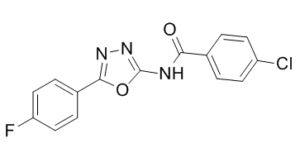KKL-35
This product is for research use only, not for human use. We do not sell to patients.

For small sizes, please check our retail website as below: www.invivochem.com
| Size | Price | Stock |
|---|---|---|
| 250mg | $1650 | Check With Us |
| 500mg | $2350 | Check With Us |
| 1g | $3525 | Check With Us |
Cat #: V4223 CAS #: 865285-29-6 Purity ≥ 98%
Description: KKL-35 is a novel, and potent small molecule inhibitor of trans-translation tagging reaction with IC50 of 0.9 µM and with broad-spectrum antibiotic activity.
Top Publications Citing Invivochem Products
Publications Citing InvivoChem Products
Product Promise

- Physicochemical and Storage Information
- Protocol
- Related Biological Data
- Stock Solution Preparation
- Quality Control Documentation
| Molecular Weight (MW) | 317.70 |
|---|---|
| Molecular Formula | C₁₅H₉ClFN₃O₂ |
| CAS No. | 865285-29-6 |
| Storage | -20℃ for 3 years in powder formr |
| -80℃ for 2 years in solvent | |
| SMILES Code | O=C(NC1=NN=NN1CCC)C2=CC=CC(Cl)=C2 |
| Synonyms | KKL35; KKL-35; KKL 35; |
| Protocol | In Vitro | KKL-35 exhibits broad-spectrum antibiotic activity. KKL-35 prevents growth of B. anthracis and M. smegmatis with minimum inhibitory concentration (MIC) values of less than 6 µM. KKL-35 inhibit trans-translation at some step before proteolysis of tagged proteins. KKL-35 inhibits tagging of DHFR-ns. A large amount of untagged DHFR is produced in reactions with the highest concentrations of KKL-35, indicating that KKL-35 does not inhibit translation. KKL-35 prevents growth of WT S. flexneri with a MIC of 6 µM, and addition of KKL-35 to a growing culture of S. flexneri stops growth. In an S. flexneri strain expressing ArfA and deleted for ssrA, addition of KKL-35 has little effect on viability or growth rate. KKL-35 inhibits the growth of E. coli ∆tolC, which is deficient in small molecule efflux, with an MIC of 0.3 µM. |
|---|---|---|
| In Vivo | Evidence suggest that the in vivo effects of KKL-35 are caused by inhibition of the release of nonstop translation complexes by trans-translation. KKL-35 inhibits trans-translation and prevents growth of S. flexneri strains that require trans-translation. The correlation between inhibition of trans-translation and growth is supported by genetic and pharmacological experiments showing that alternative mechanisms to release nonstop translation complexes relieve the growth suppression of KKL-35. |
These protocols are for reference only. InvivoChem does not
independently validate these methods.
| Solvent volume to be added | Mass (the weight of a compound) | |||
|---|---|---|---|---|
| Mother liquor concentration | 1mg | 5mg | 10mg | 20mg |
| 1mM | 3.1476 mL | 15.7381 mL | 31.4762 mL | 62.9525 mL |
| 5mM | 0.6295 mL | 3.1476 mL | 6.2952 mL | 12.5905 mL |
| 10mM | 0.3148 mL | 1.5738 mL | 3.1476 mL | 6.2952 mL |
| 20mM | 0.1574 mL | 0.7869 mL | 1.5738 mL | 3.1476 mL |
The molarity calculator equation
Mass(g) = Concentration(mol/L) × Volume(L) × Molecular Weight(g/mol)
Mass
=
Concentration
×
Volume
×
Molecular Weight*
The dilution calculator equation
Concentration(start)
×
Volume(start)
=
Concentration(final)
×
Volume(final)
This equation is commonly abbreviated as: C1 V1 = C2 V2
Concentration(start)
C1
×
Volume(start)
V1
=
Concentration(final)
C2
×
Volume(final)
V2
Step One: Enter information below
Dosage mg/kg
Average weight of animals g
Dosing volume per animal µL
Number of animals
Step Two: Enter the in vivo formulation
%DMSO
+
%
+
%Tween 80
+
%ddH2O
Calculation Results:
Working concentration:
mg/ml;
Method for preparing DMSO master liquid:
mg
drug pre-dissolved in
µL
DMSO(Master liquid concentration
mg/mL)
,Please contact us first if the concentration exceeds the DMSO solubility of the batch of drug.
Method for preparing in vivo formulation:
Take
µL
DMSO master liquid, next add
µL
PEG300, mix and clarify, next add
µL
Tween 80,mix and clarify, next add
µL
ddH2O,mix and clarify.
Note:
- (1) Please be sure that the solution is clear before the addition of next solvent. Dissolution methods like vortex, ultrasound or warming and heat may be used to aid dissolving.
- (2) Be sure to add the solvent(s) in order.




































